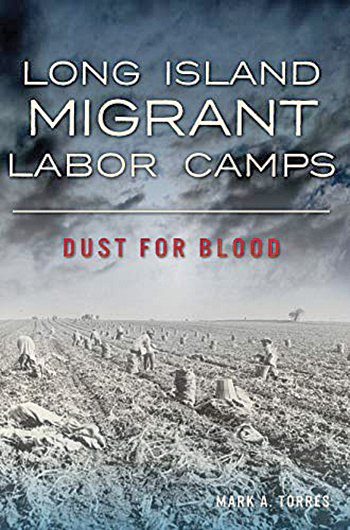New book, ‘Dust for Blood,’ details history of farm labor camps

Early on the morning of Oct. 8, 1961, back when the North Fork was a very different place, fire alarms erupted in Cutchogue and trucks and crews raced to a patch of woods at the north end of the hamlet, near Oregon Road.
“Their destination was a raging fire at the infamous farm labor camp on Cox Lane,” writes Mark Torres in his new book, “Long Island Migrant Camps: Dust for Blood,” a history of the farm labor camps that once could be found in great numbers across eastern Long Island.
“For years the camp had been used to house hundreds of farm workers who traveled from other states to harvest potatoes and other crops on the vast farms of Long Island,” writes Mr. Torres, a labor and employment attorney, who will present a virtual lecture on the camps from Oysterponds Historical Society on Saturday, March 27, at 5 p.m.
According to Mr. Torres’ research, the fire was started by a leaky kerosene cooking stove inside one of the squalid barracks at the site. The workers used the makeshift stove because they could not afford the expensive meals offered by the crew chief who managed the camp.

At the camp and at others like it, the workers were overcharged for everything — food, blankets, alcohol, beds, even transportation in the camp-owned bus — which kept them indebted to a crew boss. By week’s end, many workers received nothing in their paychecks. The system, which to some observers resembled slavery by another name, persisted for decades and was essential to the well-being of the region’s farms and the families that owned them.
The fire claimed the lives of four Black workers: Leroy McKoy, James Davis, Charles Jordan and James Overstreet. Their names have never been part of any official histories of Southold or Riverhead, where the “founding families” narrative has long reigned supreme. No marker at the site lists their names, or even acknowledges that the camp once existed there and was where Edward R. Murrow filmed a portion of his scathing documentary, “Harvest of Shame,” in the mid-1950s.
As “Dust for Blood” shows, these camps were once ubiquitous on the North Fork. According to Mr. Torres, there were 24 camps in Southold in 1960, housing 630 migrant workers. In Riverhead that year there were 30 such camps, housing 400 workers. Dozens more camps existed in Southampton and Brookhaven.
“Dust for Blood” is the first book-length treatment of this subject. Mr. Torres knew he was venturing into new territory, and said in an interview that local historians, librarians and old-timers with firsthand knowledge were supportive and helpful.
“At many times, I felt like I was chasing a ghost, but I continued with my efforts because the importance of the topic demanded it,” he said. “My research included a review of over 300 newspaper articles, government documents and other written material; a close study of several documentaries; and interviews with those familiar with the subject.”
The book contains a wealth of information about the camps and how the migrants who called them home lived. The first recorded camp was set up in Peconic in the early summer of 1943. Soon, other camps were built and by 1958 there were 134 countywide.

The last such camp of its kind, on Depot Lane in Cut-ch-ogue, was home to a half-dozen Black men and women who worked out of a big sorting barn by the railroad tracks. The barn burned to the ground in 2006, scattering the residents.
By the 1980s, as potato acreage plummeted, dozens of camps were shuttered. As Mr. Torres explains, “The factors which led to their decline include the increased use of machinery to perform farm work, an overall decline in agricultural output and rising land values, which led many farmers, who faced their own burdens, to sell their land to prospectors.”
As to why local historians have not focused on the subject, Mr. Torres points to the very pivotal role the migrant laborers played in terms of harvesting what was once thousands of acres of potatoes. In short, the agricultural industry had to have the workers.
Asked what was the most disturbing thing he learned in his research, Mr. Torres said it was certainly the deaths of adults and children in fires at camps, particularly in Riverhead Town. In 1959, for instance, there were eight deaths over the course of 11 days.
Beyond that, he said the squalid conditions in the camps and the system designed to keep the workers in place and in debt, never to return to their hometowns in the South, still haunt him.
His book points out there were those who did work to improve conditions at the camps and to expose them as well. Some journalists, including Les Payne, a former Newsday editor who lived in a Riverhead labor camp for a week and wrote about his experiences, shined bright light on the fate of the workers.
Time and changing regulations, not necessarily humanitarian concerns, ended the horrific camps in Riverhead that were home to hundreds of men and women who worked on the duck farms that once existed on nearly every salt creek. The camps were regulated by the Suffolk County Department of Health, and many of them were eventually closed because of widespread pollution in the creeks and bays.
The story Mr. Torres tells is, in many ways, both new and deeply sad. Workers recruited in places like Arkansas were charged for the bus ride to the North Fork. The moment they stepped on the bus they were already in debt. At the Cox Lane camp, the crew boss had a commissary called the Dixie Bell Inn. A bottle of wine was $1.25. A bed was an additional charge.
“Workers when they got on the bus were promised great living conditions, a restaurant on the grounds and [that] they could return at the end of the season to their home towns,” Mr. Torres said.
Little of that was true. “The workers believed this was a way to do better,” he said. “History tells us otherwise … The complete indifference by the public, by the farmers, by the crew chiefs — that was shocking.
“There is no dispute there was a labor shortage on the farms,” Mr. Torres added. “They solved it at the expense of human life.”








